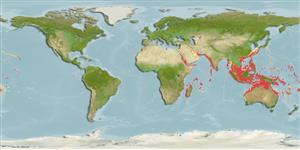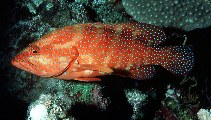Cephalopholis miniata (Forsskål, 1775)
Coral hind
Добавить Ваши наблюдения в Fish Watcher
| Native range | All suitable habitat | Point map | Year 2050 |

|
| This map was computer-generated and has not yet been reviewed. |
| Cephalopholis miniata AquaMaps Data sources: GBIF OBIS |
Загрузить свой Фото и Видео
Pictures | Videos | Stamps, coins, misc. | Изображение на GoogleCephalopholis miniata
Picture by Randall, J.E.
Pictures | Videos | Stamps, coins, misc. | Изображение на GoogleCephalopholis miniata
Picture by Randall, J.E.
Saudi Arabia country information
Common names:
Hamoor, عجوز المرجان
Occurrence: native
Salinity: marine
Abundance: | Ref:
Importance: | Ref:
Aquaculture: | Ref:
Regulations: | Ref:
Uses: no uses
Comments: Also Ref. 4787. Museum: ZMUC P43567.
National Checklist:
Country Information: https://www.cia.gov/library/publications/resources/the-world-factbook/geos/sa.html
National Fisheries Authority:
Occurrences: Occurrences Point map
Main Ref: Heemstra, P.C. and J.E. Randall, 1993
National Database:
Occurrence: native
Salinity: marine
Abundance: | Ref:
Importance: | Ref:
Aquaculture: | Ref:
Regulations: | Ref:
Uses: no uses
Comments: Also Ref. 4787. Museum: ZMUC P43567.
National Checklist:
Country Information: https://www.cia.gov/library/publications/resources/the-world-factbook/geos/sa.html
National Fisheries Authority:
Occurrences: Occurrences Point map
Main Ref: Heemstra, P.C. and J.E. Randall, 1993
National Database:
Common names from other countries
Классификация / Names народные названия | синонимы | Catalog of Fishes(род, виды) | ITIS | CoL | WoRMS | Cloffa
> Perciformes/Serranoidei (Groupers) > Epinephelidae (Groupers)
Etymology: Cephalopholis: Greek, kephale = head + Greek, pholis = scale (Ref. 45335).
More on author: Forsskål.
Etymology: Cephalopholis: Greek, kephale = head + Greek, pholis = scale (Ref. 45335).
More on author: Forsskål.
Environment: milieu / climate zone / depth range / distribution range экология
морской ассоциированный с рифами; немигрирующий; пределы глубины 2 - 150 m (Ref. 9710). Tropical; 35°N - 32°S, 30°E - 156°W (Ref. 5222)
распространение страны | регионы FAO | Ecosystems | места находок | Point map | интродукции | Faunafri
Indo-Pacific: Red Sea to Durban, South Africa and eastward to the Line Islands; including most islands in the Indian and west-central Pacific oceans. Absent from Persian Gulf and Gulf of Oman. Misidentified as Cephalopholis cyanostigma from Reunion (Ref. 6453).
Length at first maturity / Size / Вес / Возраст
Краткое описание определительные ключи | морфология | морфометрия
колючие лучи спинного плавника (общее число) : 9; членистые (мягкие) лучи спинного плавника (общее число) : 14 - 15; колючие лучи анального плавника: 3; членистые (мягкие) лучи анального плавника: 8 - 9. Color orange-red to reddish brown, usually dark posteriorly with numerous bright blue spots which are smaller than the pupil and often faintly dark-edged on head, body and median fins; distal margin of caudal fin and soft portions of dorsal and anal fins usually with a narrow blue margin and blackish submarginal line; orange-yellow pectoral fins, on some only distally; orange-red pelvic fins; it is capable of a disruptive color pattern of irregular oblique olivaceous bars; juveniles may be yellow with scattered faint blue spots. D IX, 14-16; A III, 8-9 (rarely 8); pectoral 17-18 (often 18); scales on lateral line 47-55; scales on longitudinal series 94-114; snout anterior to nostrils no scales; partially scaled maxilla; abdomen with cycloid scales; gill rakers 7-9 + 13-15; depth of body 2.65-3.05 in SL; length of head 2.4-2.65 in SL; the maxilla extends to or posterior to rear of the orbit; smooth ventral margin of preopercle; 5th - 8th dorsal spines longest , 3.0-3.6 in head; pectoral fins 1.45-1.75 in head; pelvic fins do not reach the anus, 1.9-2.3 in head (Ref. 4787).
Inhabit clear waters of coral reefs; more often found in exposed rather than protected reef areas (Ref. 5213). Feed on fishes (80%, mainly Pseudanthias squamipinnis) and crustaceans. Form haremic groups comprising of a dominant male and 2 to 12 females. These groups occupy territories of up to 475 sq m subdivided into secondary territories and defended by a single female (Ref. 6480). Generally common (Ref. 9710).
Life cycle and mating behavior половая зрелость | размножение | нерест | икра | Fecundity | личинки
Основная ссылка
Upload your references | ссылки | координатор | соавторы
Heemstra, P.C. and J.E. Randall, 1993. FAO Species Catalogue. Vol. 16. Groupers of the world (family Serranidae, subfamily Epinephelinae). An annotated and illustrated catalogue of the grouper, rockcod, hind, coral grouper and lyretail species known to date. Rome: FAO. FAO Fish. Synop. 125(16):382 p. (Ref. 5222)
Статус Красного Списка МСОП (Ref. 130435: Version 2024-2)
Не вызывающий беспокойства (LC) ; Date assessed: 12 November 2017
Угроза для людей
Harmless
Использование человеком
рыболовство: коммерческий; объект спортивного рыболовства: да; аквариум: коммерческий
FAO(рыболовство: production; publication : search) | FishSource | Sea Around Us
дополнительная информация
Population dynamics
Growth parameters
Max. ages / sizes
Length-weight rel.
Length-length rel.
Размерный состав
Mass conversion
пополнение
численность
Growth parameters
Max. ages / sizes
Length-weight rel.
Length-length rel.
Размерный состав
Mass conversion
пополнение
численность
Life cycle
размножение
половая зрелость
Fecundity
нерест
Spawning aggregations
икра
Развитие икры
личинки
динамика численности личинок
размножение
половая зрелость
Fecundity
нерест
Spawning aggregations
икра
Развитие икры
личинки
динамика численности личинок
Physiology
Body composition
Nutrients
Oxygen consumption
Swimming type
Swimming speed
Visual pigments
Fish sound
Diseases & Parasites
Toxicity (LC50s)
Body composition
Nutrients
Oxygen consumption
Swimming type
Swimming speed
Visual pigments
Fish sound
Diseases & Parasites
Toxicity (LC50s)
Genetics
генетика
Heterozygosity
наследуемость
генетика
Heterozygosity
наследуемость
Human related
Aquaculture systems
особенности рыбоводства
степень растяжения
Ciguatera cases
Stamps, coins, misc.
Aquaculture systems
особенности рыбоводства
степень растяжения
Ciguatera cases
Stamps, coins, misc.
инструменты
Bio-Quiz | E-book | полевой определитель | определительные ключи | Длина-Частота | онтогенез | карта точек | Classification Tree
| Catch-MSY |
Специальные отчеты
Проверить содержание в аквариумах | Проверить опубликованные видовые данные | Проверить опубликованные данные по аквакультуре
Скачать в формате XML
ресурсы в Интернет
Aquatic Commons | BHL | Cloffa | BOLDSystems | Websites from users | Проверить FishWatcher | CISTI | Catalog of Fishes(род, виды) | DiscoverLife | DORIS | ECOTOX | Faunafri | Fishtrace | GenBank(Геном, Нуклеотид) | GloBI | GOBASE | | Google Books | Google Scholar | Google | IGFA World Record | MitoFish | национальные базы данных | Otolith Atlas of Taiwan Fishes | общественные аквариумы | PubMed | Reef Life Survey | Scirus | SeaLifeBase | Tree of Life | Wikipedia(Вперёд, поиск) | World Records Freshwater Fishing | Zoological Record
Estimates based on models
Preferred temperature (Ref. 115969): 23.7 - 29, mean 27.8 (based on 2104 cells).
Phylogenetic diversity index (Ref. 82804): PD50 = 0.5000 [Uniqueness, from 0.5 = low to 2.0 = high].
Bayesian length-weight: a=0.01072 (0.00714 - 0.01608), b=3.06 (2.94 - 3.18), in cm Total Length, based on LWR estimates for this species & Genus-body shape (Ref. 93245).
Trophic level (Ref. 69278): 4.3 ±0.5 se; based on diet studies.
устойчивость к внешним воздействиям (Ref. 120179): низкий, минимальное время удвоения популяции 4.5-14 лет (tmax=30; K=0.101).
Fishing Vulnerability (Ref. 59153): High to very high vulnerability (65 of 100).
Climate Vulnerability (Ref. 125649): High vulnerability (57 of 100).




